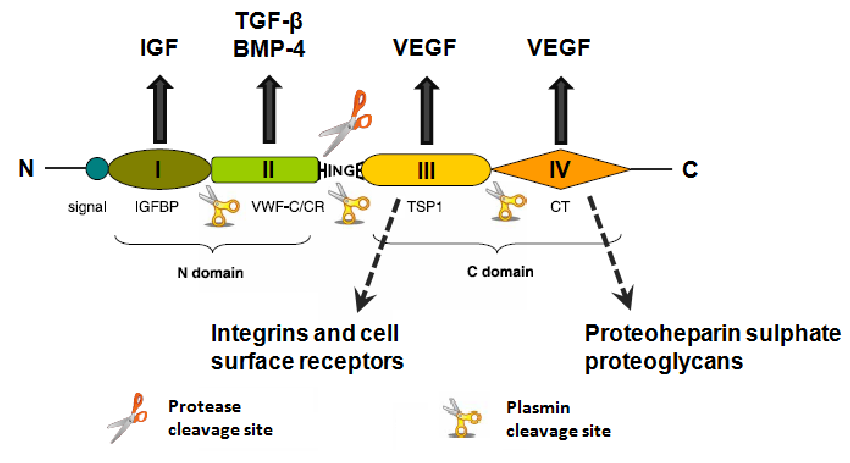What is CTGF Protein?
Connective tissue growth factor (CTGF), also known as CCN2, is a member of the CCN (Cyr61, CTGF, Nov) family of matricellular proteins, six highly conserved, secreted proteins with vital roles in cellular processes.
Discovery and Background of CTGF Protein
The CTGF protein was initially discovered in the early 1990s in the conditioned media of human umbilical vein endothelial cells (HUVECs) stimulated by vascular endothelial growth factor (VEGF). It was observed that this newly found protein could promote the adhesion of fibroblasts, thus relegating it the name 'connective tissue growth factor.'
Gene Locus and Protein Structure
The CTGF gene is located on the long arm of chromosome 6 (6q23.2) in humans. It spans about 6.5kb on genomic DNA, comprising five exons and four introns. The CTGF protein has a modular structure with four separate domains with individual and shared functions– an insulin-like growth factor-binding protein domain (IGFBP), a von Willebrand factor type C repeat domain (vWC), a thrombospondin type-1 repeat domain (TSP-1), and a cysteine knot-containing domain (CT). This multi-domain structure enables multifunctionality, binding to variably interacting partners, and involvement in diverse biological processes.

Fig1. Protein structure of CTGF
Function of CTGF Protein
CTGF plays an indispensable role in several biological processes. It is a vital regulator of cell adhesion, migration, proliferation, angiogenesis, skeletal development, and tissue wound repair. CTGF mediates these functions through its ability to interact with various molecules such as matrix metalloproteinases, integrins, low-density lipoprotein receptor-related proteins, and various growth factors, to modulate different signaling pathways.
CTGF Protein Related Signal Pathway
CTGF primarily exercises its activities through the TGF-β/Smad signaling pathway. When CTGF binds to its receptor (like integrins or LRP), intracellular signaling pathways are activated leading to the phosphorylation and nuclear translocation of Smad2/3 proteins. Additionally, CTGF also interacts with the Wnt/PCP and MAPK/ERK pathways, affecting cytoskeletal dynamics and gene transcription.
CTGF Protein Related Diseases
Overexpression or under-expression of CTGF contributes to various pathological conditions. Overexpression has been linked with organ fibrosis (including pulmonary, renal, and liver fibrosis), cancer progression, and arteriosclerosis. It also has a role in pathological angiogenesis, thus contributing to diseases like age-related macular degeneration and diabetic retinopathy.
CTGF Protein's Applications in Biomedical
The discovery of the critical role that CTGF plays in numerous diseases has led to a focus on it as a potential therapeutic target. Antisense oligonucleotides, antibody-based therapies, small molecule inhibitors, and peptidomimetics are being developed to target CTGF, particularly for fibrotic diseases and cancer. In fibrotic diseases, treating patients with anti-CTGF antibodies has been well-tolerated with improved lung function and stabilized disease progression reported in clinical trials. Similarly, antisense oligonucleotide treatment targeting CTGF has shown positive results in diabetic nephropathy patients.
Furthermore, in cancer, CTGF has gained attention as a potential diagnostic and prognostic biomarker due to its overexpression in various cancer types.
In conclusion, the CTGF protein, much like a double-edged sword, participates in both the normal development and progression of pathological conditions. Understanding this protein's various roles in different biological processes has opened new doors for diagnosis, prognosis, and treatment of various diseases. As research on CTGF continues, we can hope for the emergence of more targeted therapies and their successful translation into clinical application.
Our Featured Products
| Cat.No. | Product Name | Species | Source (Host) | Tag |
|---|---|---|---|---|
| CTGF-2605H | Recombinant Human CTGF, His-tagged | Human | HEK293 | His |
| CTGF-2466H | Recombinant Human CTGF protein, His-tagged | Human | E.coli | His |
| CTGF-2604H | Active Recombinant Human CTGF protein, His-Avi-tagged, Biotinylated | Human | HEK293 | His-Avi |
| CTGF-2554H | Recombinant Human CTGF protein, His-tagged | Human | E.coli | His |
| CTGF-1654R | Recombinant Rat CTGF Protein | Rat | Mammalian Cell | His |
| Ctgf-544R | Recombinant Rat Ctgf protein, His-tagged | Rat | E.coli | His |
| CTGF-1313R | Recombinant Rat CTGF Protein, His (Fc)-Avi-tagged | Rat | HEK293 | His (Fc)-Avi |
Reference
- Kittana, Naim. (2014). Role of Secretory Processes in Cardiac Fibroblasts in Heart Failure Development and Progression. 10.13140/2.1.2955.1681.

